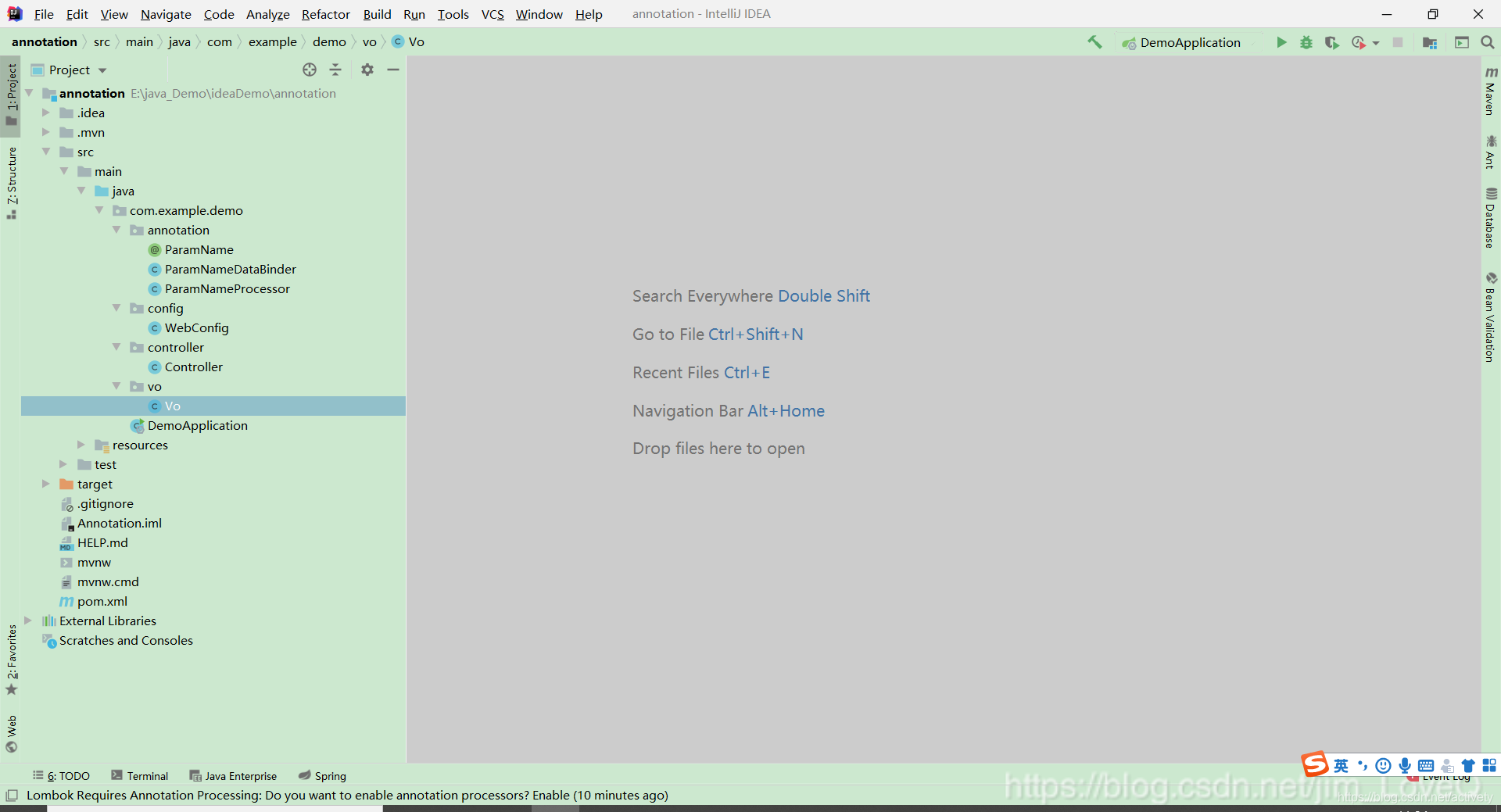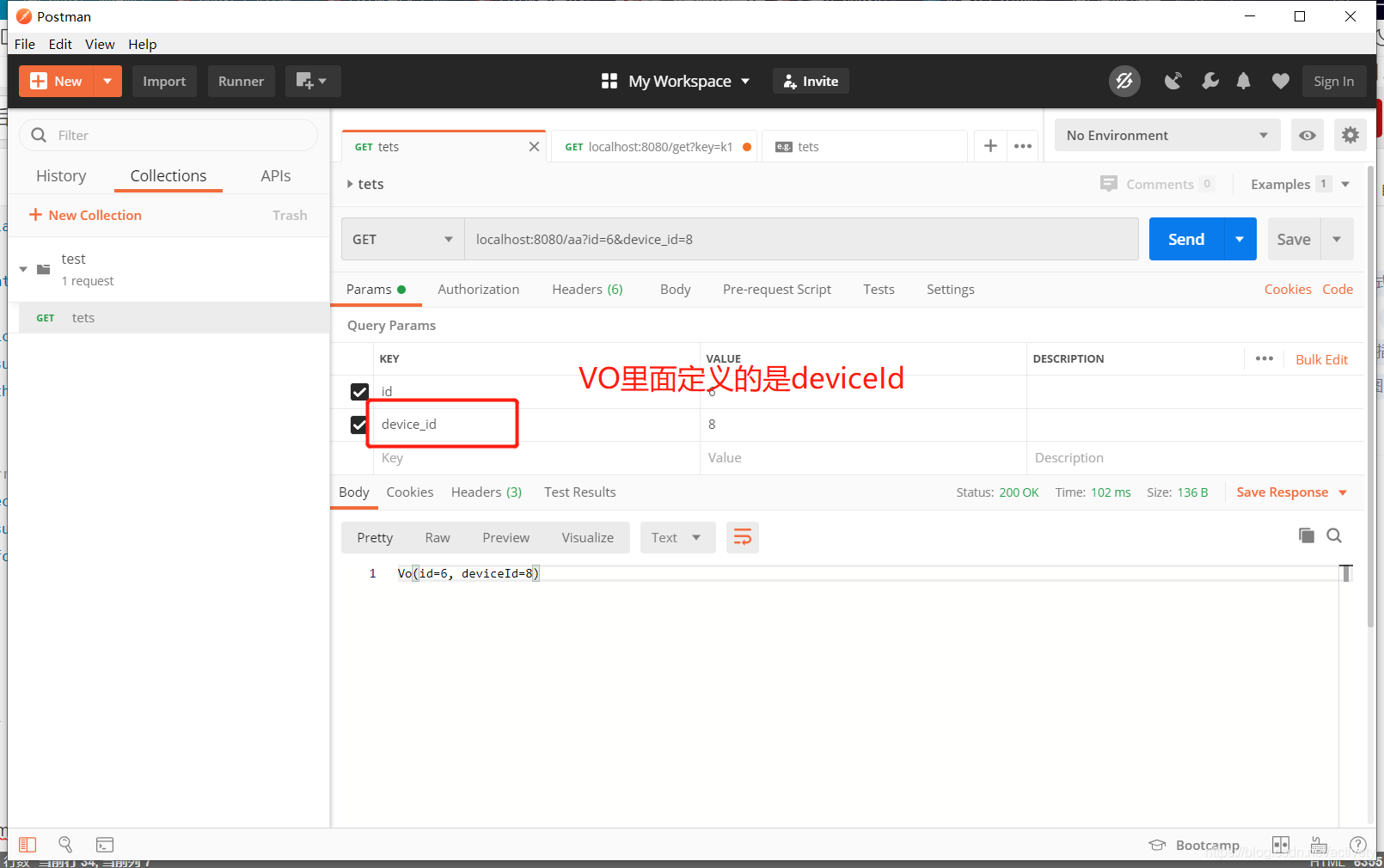描述:实体类有一个字段deviceId,前端传递参数为device_id
代码下载地址:https://download.youkuaiyun.com/download/activety/12462144
目录结构:

VO类
@Data
public class Vo{
private Integer id;
@ParamName("device_id")
private String deviceId;
}
Controller类
@RestController
public class Controller {
/**
* @param job
* @RequestParam这个注解非常重要
*/
@RequestMapping("/aa")
@ResponseBody
public String test(@RequestParam Vo job) {
System.out.println(job.toString());
return job.toString();
}
}
自定义注解ParamName
@Inherited
@Documented
@Target(ElementType.FIELD)
@Retention(RetentionPolicy.RUNTIME)
public @interface ParamName {
String value();
}
ParamNameDataBinder
import org.springframework.beans.MutablePropertyValues;
import org.springframework.web.servlet.mvc.method.annotation.ExtendedServletRequestDataBinder;
import javax.servlet.ServletRequest;
import java.util.Map;
public class ParamNameDataBinder extends ExtendedServletRequestDataBinder {
private final Map<String, String> paramMappings;
public ParamNameDataBinder(Object target, String objectName, Map<String, String> paramMappings) {
super(target, objectName);
this.paramMappings = paramMappings;
}
@Override
protected void addBindValues(MutablePropertyValues mutablePropertyValues, ServletRequest request) {
super.addBindValues(mutablePropertyValues, request);
for (Map.Entry<String, String> entry : paramMappings.entrySet()) {
String paramName = entry.getKey();
String fieldName = entry.getValue();
if (mutablePropertyValues.contains(paramName)) {
mutablePropertyValues.add(fieldName, mutablePropertyValues.getPropertyValue(paramName).getValue());
}
}
}
}
ParamNameProcessor
import org.springframework.beans.BeanUtils;
import org.springframework.beans.factory.annotation.Autowired;
import org.springframework.core.MethodParameter;
import org.springframework.web.bind.WebDataBinder;
import org.springframework.web.bind.annotation.RequestParam;
import org.springframework.web.context.request.NativeWebRequest;
import org.springframework.web.servlet.mvc.method.annotation.RequestMappingHandlerAdapter;
import org.springframework.web.servlet.mvc.method.annotation.ServletModelAttributeMethodProcessor;
import java.lang.reflect.Field;
import java.util.Arrays;
import java.util.HashMap;
import java.util.Map;
import java.util.concurrent.ConcurrentHashMap;
public class ParamNameProcessor extends ServletModelAttributeMethodProcessor {
@Autowired
private RequestMappingHandlerAdapter requestMappingHandlerAdapter;
private static final Map<Class<?>, Map<String, String>> PARAM_MAPPINGS_CACHE = new ConcurrentHashMap<>(256);
public ParamNameProcessor() {
super(false);
}
@Override
public boolean supportsParameter(MethodParameter parameter) {
return parameter.hasParameterAnnotation(RequestParam.class)
&& !BeanUtils.isSimpleProperty(parameter.getParameterType())
&& Arrays.stream(parameter.getParameterType().getDeclaredFields())
.anyMatch(field -> field.getAnnotation(ParamName.class) != null);
}
@Override
protected void bindRequestParameters(WebDataBinder binder, NativeWebRequest nativeWebRequest) {
Object target = binder.getTarget();
Map<String, String> paramMappings = this.getParamMappings(target.getClass());
ParamNameDataBinder paramNameDataBinder = new ParamNameDataBinder(target, binder.getObjectName(), paramMappings);
requestMappingHandlerAdapter.getWebBindingInitializer().initBinder(paramNameDataBinder, nativeWebRequest);
super.bindRequestParameters(paramNameDataBinder, nativeWebRequest);
}
/**
* @param targetClass
* @return {@link Map<String, String>}
*/
private Map<String, String> getParamMappings(Class<?> targetClass) {
if (PARAM_MAPPINGS_CACHE.containsKey(targetClass)) {
return PARAM_MAPPINGS_CACHE.get(targetClass);
}
Field[] fields = targetClass.getDeclaredFields();
Map<String, String> paramMappings = new HashMap<>(32);
for (Field field : fields) {
ParamName paramName = field.getAnnotation(ParamName.class);
if (paramName != null && !paramName.value().isEmpty()) {
paramMappings.put(paramName.value(), field.getName());
}
}
PARAM_MAPPINGS_CACHE.put(targetClass, paramMappings);
return paramMappings;
}
}
WebConfig
mport com.example.demo.annotation.ParamName;
import com.example.demo.annotation.ParamNameProcessor;
import org.springframework.beans.BeansException;
import org.springframework.beans.factory.config.BeanPostProcessor;
import org.springframework.context.annotation.Bean;
import org.springframework.context.annotation.Configuration;
import org.springframework.web.method.support.HandlerMethodArgumentResolver;
import org.springframework.web.servlet.mvc.method.annotation.RequestMappingHandlerAdapter;
import java.util.ArrayList;
import java.util.List;
@Configuration
public class WebConfig {
@Bean
protected ParamNameProcessor paramNameProcessor() {
return new ParamNameProcessor();
}
@Bean
public BeanPostProcessor beanPostProcessor() {
return new BeanPostProcessor() {
@Override
public Object postProcessBeforeInitialization(Object bean, String beanName) throws BeansException {
return bean;
}
@Override
public Object postProcessAfterInitialization(Object bean, String beanName) throws BeansException {
if (bean instanceof RequestMappingHandlerAdapter) {
RequestMappingHandlerAdapter adapter = (RequestMappingHandlerAdapter) bean;
List<HandlerMethodArgumentResolver> argumentResolvers = new ArrayList<>(adapter.getArgumentResolvers());
argumentResolvers.add(0, paramNameProcessor());
adapter.setArgumentResolvers(argumentResolvers);
}
return bean;
}
};
}
}
XML
<?xml version="1.0" encoding="UTF-8"?>
<project xmlns="http://maven.apache.org/POM/4.0.0" xmlns:xsi="http://www.w3.org/2001/XMLSchema-instance"
xsi:schemaLocation="http://maven.apache.org/POM/4.0.0 https://maven.apache.org/xsd/maven-4.0.0.xsd">
<modelVersion>4.0.0</modelVersion>
<parent>
<groupId>org.springframework.boot</groupId>
<artifactId>spring-boot-starter-parent</artifactId>
<version>2.1.6.RELEASE</version>
<relativePath/> <!-- lookup parent from repository -->
</parent>
<groupId>com.example</groupId>
<artifactId>demo</artifactId>
<version>0.0.1-SNAPSHOT</version>
<name>demo</name>
<description>Demo project for Spring Boot</description>
<properties>
<java.version>1.8</java.version>
</properties>
<dependencies>
<dependency>
<groupId>org.springframework.boot</groupId>
<artifactId>spring-boot-starter-web</artifactId>
</dependency>
<dependency>
<groupId>org.springframework.boot</groupId>
<artifactId>spring-boot-starter-test</artifactId>
<scope>test</scope>
</dependency>
<dependency>
<groupId>org.projectlombok</groupId>
<artifactId>lombok</artifactId>
<optional>true</optional>
</dependency>
</dependencies>
<build>
<plugins>
<plugin>
<groupId>org.springframework.boot</groupId>
<artifactId>spring-boot-maven-plugin</artifactId>
</plugin>
</plugins>
</build>
</project>
测试结果:




















 825
825

 被折叠的 条评论
为什么被折叠?
被折叠的 条评论
为什么被折叠?








